In a special exhibit to open this summer, the Philadelphia Museum of Art will display the comprehensive plan that Frank Gehry has created for the renovation and expansion of its home on the Benjamin Franklin Parkway.
Museum officials recently released renderings of Gehry's final design, which reorganizes and expands the building, adding more than 169,000 sf of space. The project will ultimately transform the interior of one of the city’s most iconic buildings, enabling the museum to display much more of its world-renowned collection.
Gehry’s design focuses on the transformation of the interior of the Museum through the renovation of beloved spaces such as the Great Stair Hall and major improvements to how visitors will enter and move through the building. The design also calls for the creation of a significant amount of new space for expanded educational activities and the display of the museum’s extensive holdings of American, Asian, and modern and contemporary art in new galleries created both within the existing building and underneath the East Terrace.
"We began by studying the character of this wonderful building—its DNA, so to speak. It is rare to have the bones of the existing building show you the way to expand it," said Gehry. "From there, we used the significant assets that the original architects gave us to create a strong entry sequence and circulation pattern that connects the new galleries to the existing building in a way that makes the new galleries seem like they have always been there. My goal is to make the building feel like one coherent design statement."
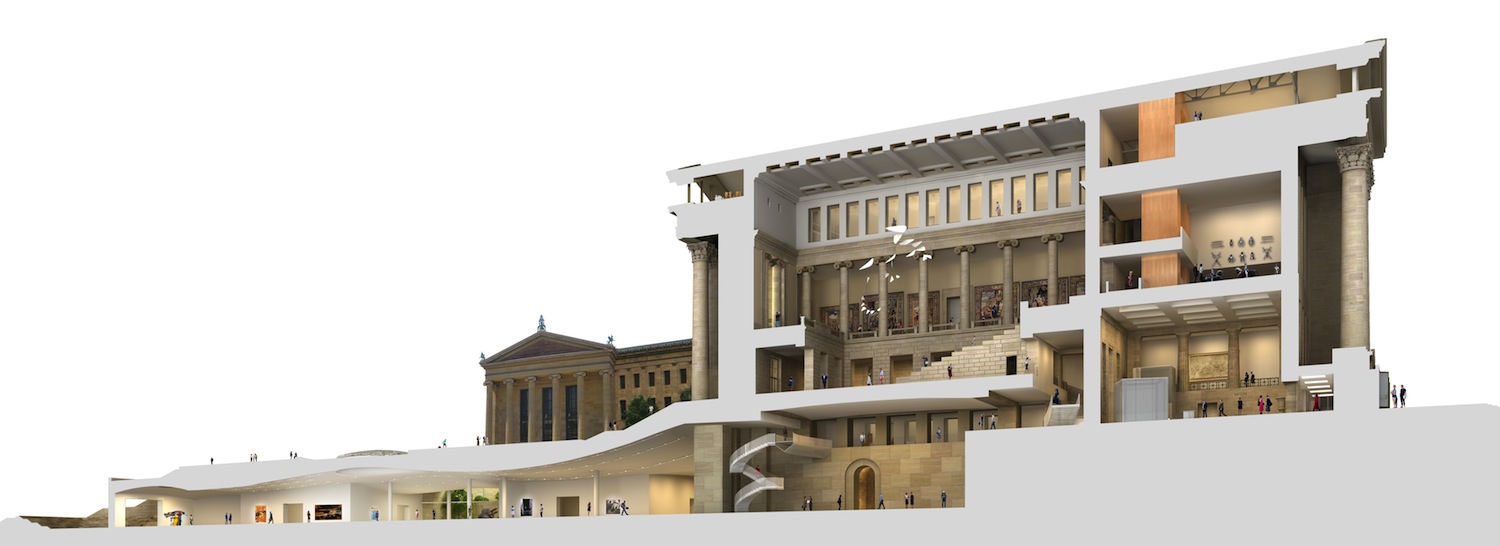
A cross-section view showing the changes to existing interior spaces and the new underground galleries. Rendering: Gehry Partners
Given the prominence of the Museum’s main building as a landmark, minimal changes have been proposed for the exterior by Gehry Partners and OLIN, the noted Philadelphia firm specializing in landscape architecture, planning, and urban design. These changes include:
• The redesign of the plaza in front of the west entrance and the landscaping of a substantial portion of the area now used for parking on this side of the building.
• The integration of skylights and sunken gardens into the east terrace to bring natural light into the new galleries that have been proposed.
• The addition on the northeast and southeast corners of the building of stair enclosures that will be simple in form and clad in the same sandstone used on the exterior in order to be as unobtrusive as possible.
By contrast, many significant changes have been proposed for the interior, yielding an increase of 124,000 sf of public space, including 78,000 sf of gallery space throughout the building. Other changes address access and circulation through the varying “ground” levels of the facility.
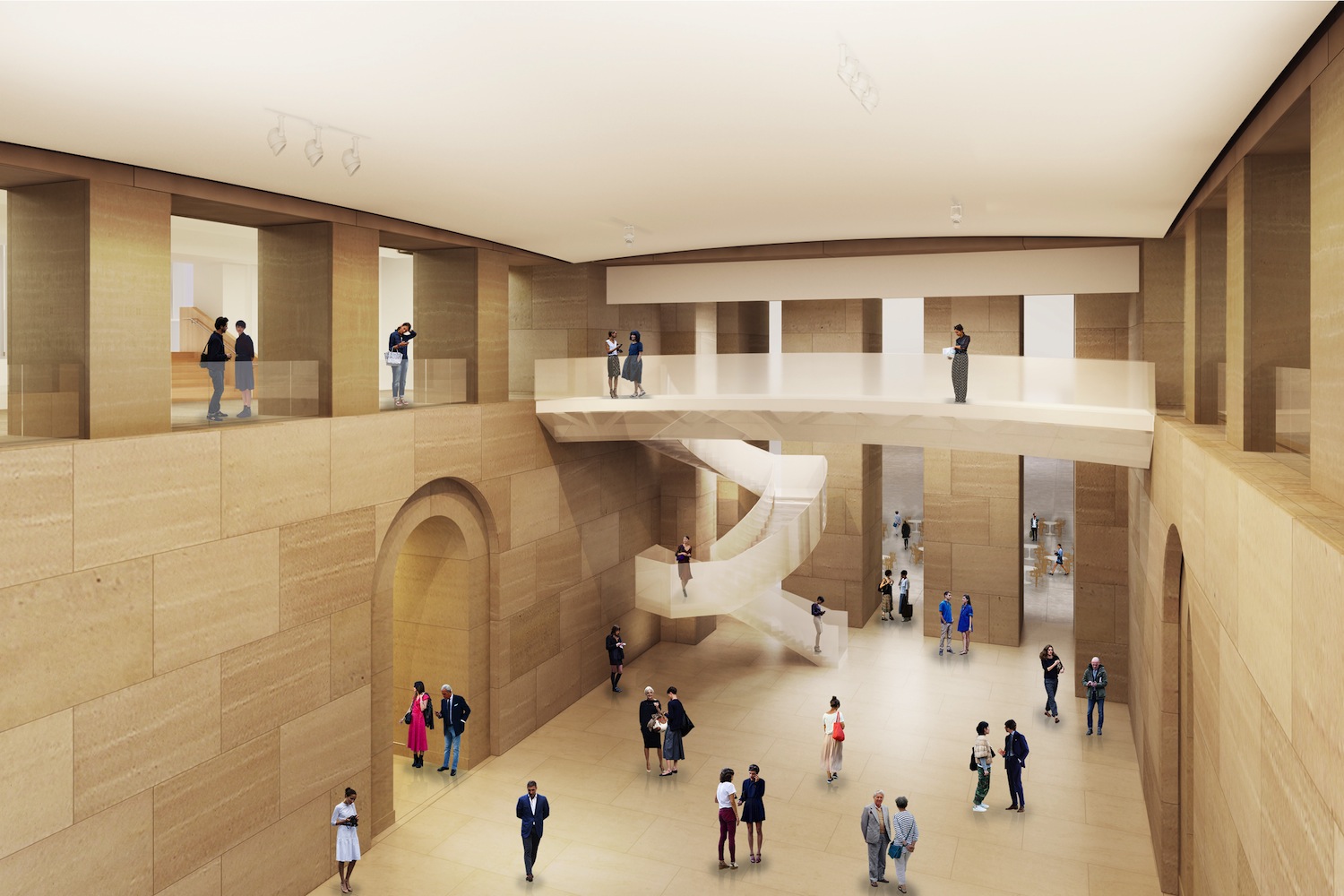
Forum Gallery: The heart of the museum will be opened up, creating a clear sight line through the ground-floor and first-floor galleries that will greatly simplify wayfinding. Rendering: Gehry Partners
At present, visitors enter the museum on the first floor through the east entrance and the Great Stair Hall or on the slightly lower floor through the west entrance and Lenfest Hall. The Gehry design will open new spaces to explore, such as the Forum and new galleries under the East Terrace.
Among the interior changes are:
• The renovation of the two principal public entrance spaces in the museum: Lenfest Hall and the Great Stair Hall.
• The creation of a new public space, or Forum, immediately below the Great Stair Hall in the center of the U-shaped Museum building. The forum will dramatically improve circulation on this floor and open up the east-west axis at the center of the building, enabling visitors to reach the new galleries and adjacent public spaces that Gehry Partners have proposed be built below the East Terrace.
• The relocation of a variety of back-office functions to add nearly 23,000 sf of new gallery space within the existing building; the creation of a new 10,000-sf education center; and the development of new visitor amenities, including a restaurant, café, and spaces for the museum store.
• The creation of 55,000 sf of new space for the presentation of special exhibitions and works from the collection in galleries underneath the east terrace. Ranging in height from 24 to 28 feet, with a vaulted ceiling supported on slender columns, these new galleries will be among the largest and most spacious in the entire Museum. Open in plan and filled with natural light, they will provide an ideal setting for the display of modern and contemporary art.
• The reopening of a public entrance on the north side of the museum. Closed to the public since the 1970s, this monumental arched entrance adjacent to Kelly Drive will be renovated to provide access to a grand vaulted corridor—part of the original design of the building—that runs 640 feet from the north to the south side of the building. This walkway will provide access to the new galleries through a long, vaulted arcade and will intersect with the new Forum directly below the Great Stair Hall, thus providing access to the entire building for visitors entering on this level.
• A new 299-seat auditorium equipped for lectures, performances, and public events, to be located underneath the northwest terrace of the main building and directly accessible from the new public entrance facing Kelly Drive.
• The adaptation of the center portion of the top floor of the U-shaped Museum building to create meeting and event spaces, and the replacement of the brick in the pediments with glass to provide dramatic views of the city and Fairmount Park.
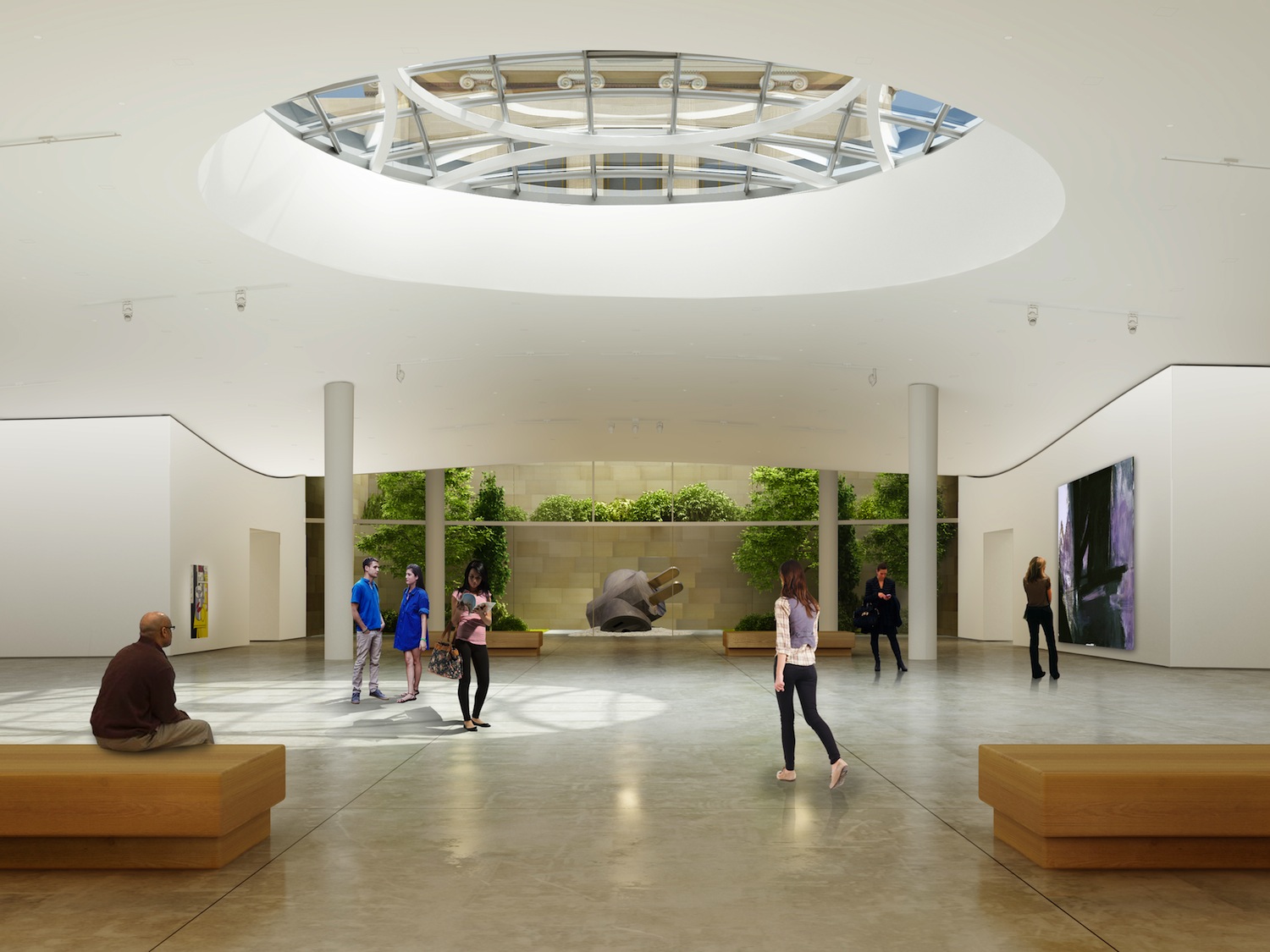
Level C Galleries: The new underground galleries will be lit in part by a skylight in the East Terrace. Rendering: Gehry Partners
“Given the ambitious scope of the plan, it has been designed in separate phases that can be implemented as funds become available," said Gail Harrity, the Museum’s President and COO. "This work must begin with—and be sustained by—an inspiring and persuasive vision of the future, recognizing that it will take years to implement the brilliant plan developed by Frank Gehry and his partners.”
The Building Team includes:
Architects: Gehry Partners, LLP, OLIN
Structural/civil engineer: Magnusson Klemenic Associates
MEP engineer: AltieriSeborWieber
BIM consultant: Gehry Technologies Inc.
Life safety/fire protection: Hughes Associates
Lighting consultant: L’Observatoire
Daylighting consultant: Loisos + Ubbelohde Associates
Theater/AV consultant: Auerbach Pollock Friedlander
Specification writer: CG Associates
Environmental design engineering: Atelier Ten
Waterproofing consultant: Henshell & Buccellato, Consulting Architects
Acoustical engineer: Cerami & Associates
IT/AV consultant: Shen Milsom & Wilke
Security consultant: Ducibella, Venter & Santore
Vertical transportation: Lerch Bates, Inc.
Exterior enclosure: Gordon H. Smith Corporation
Urban design: Urban Strategies Inc/JZTI
Historic preservation architect: Kelly/Maiello Inc.
Cost estimation: AECOM
Site survey: Pennoni Associates Inc.
Geotechnical engineering: Haley & Aldrich
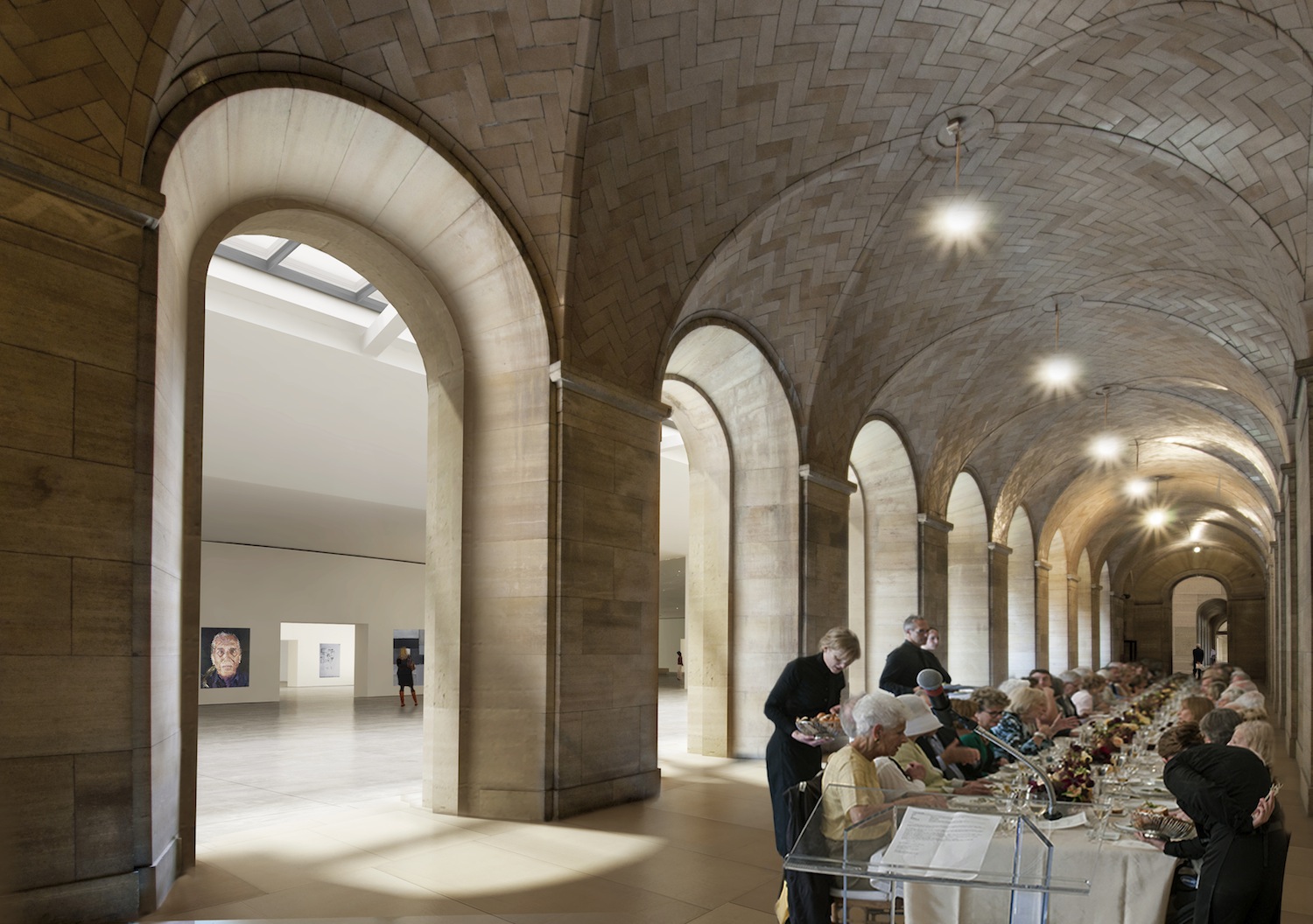
Vaulted Walkway: The vaulted underground walkway, long closed to visitors, will become a space for art and events, with entrances at the north (Kelly Drive) and south (Schuylkill River) sides of the building. Rendering: Gehry Partners
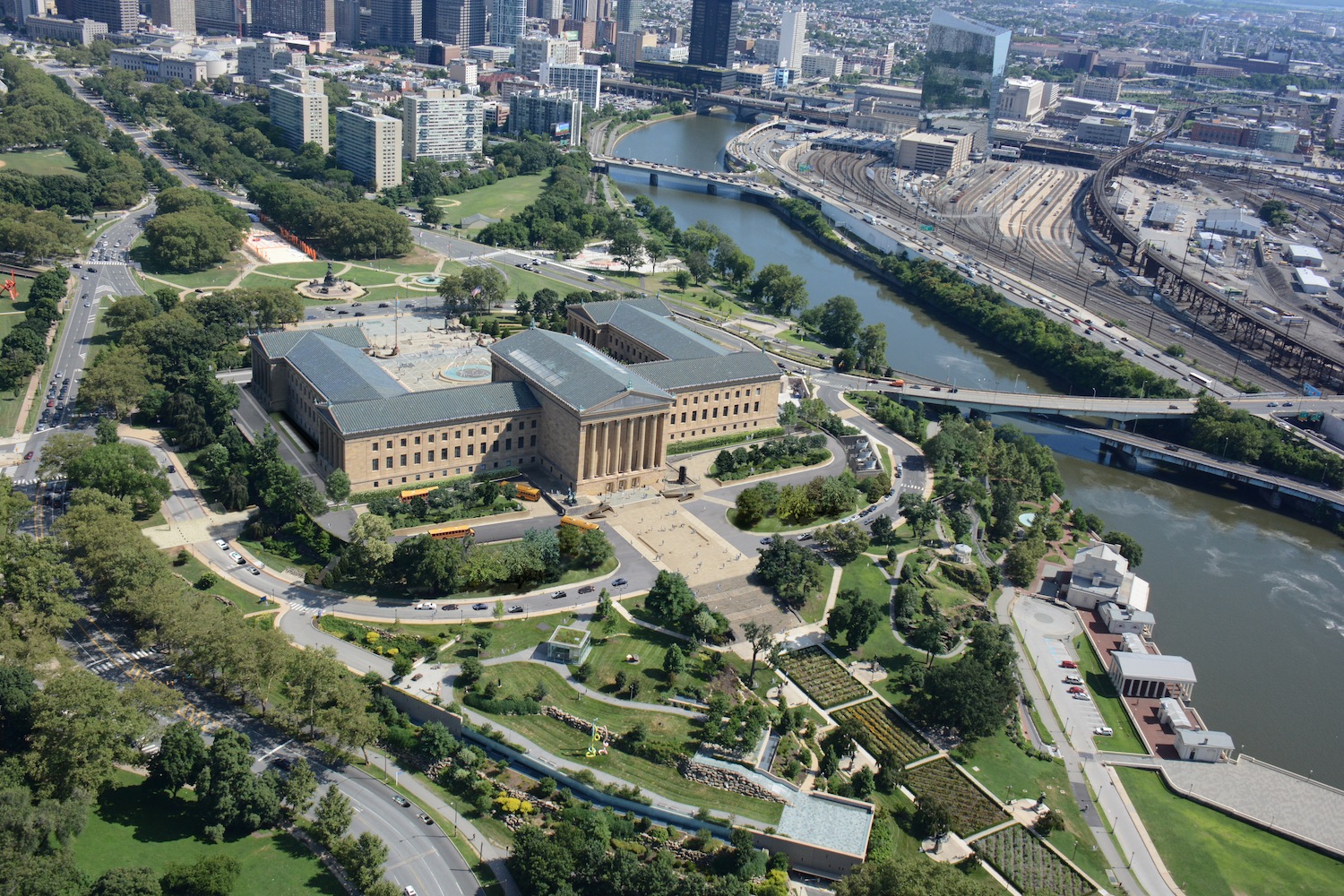
West Terrace. Rendering: Gehry Partners
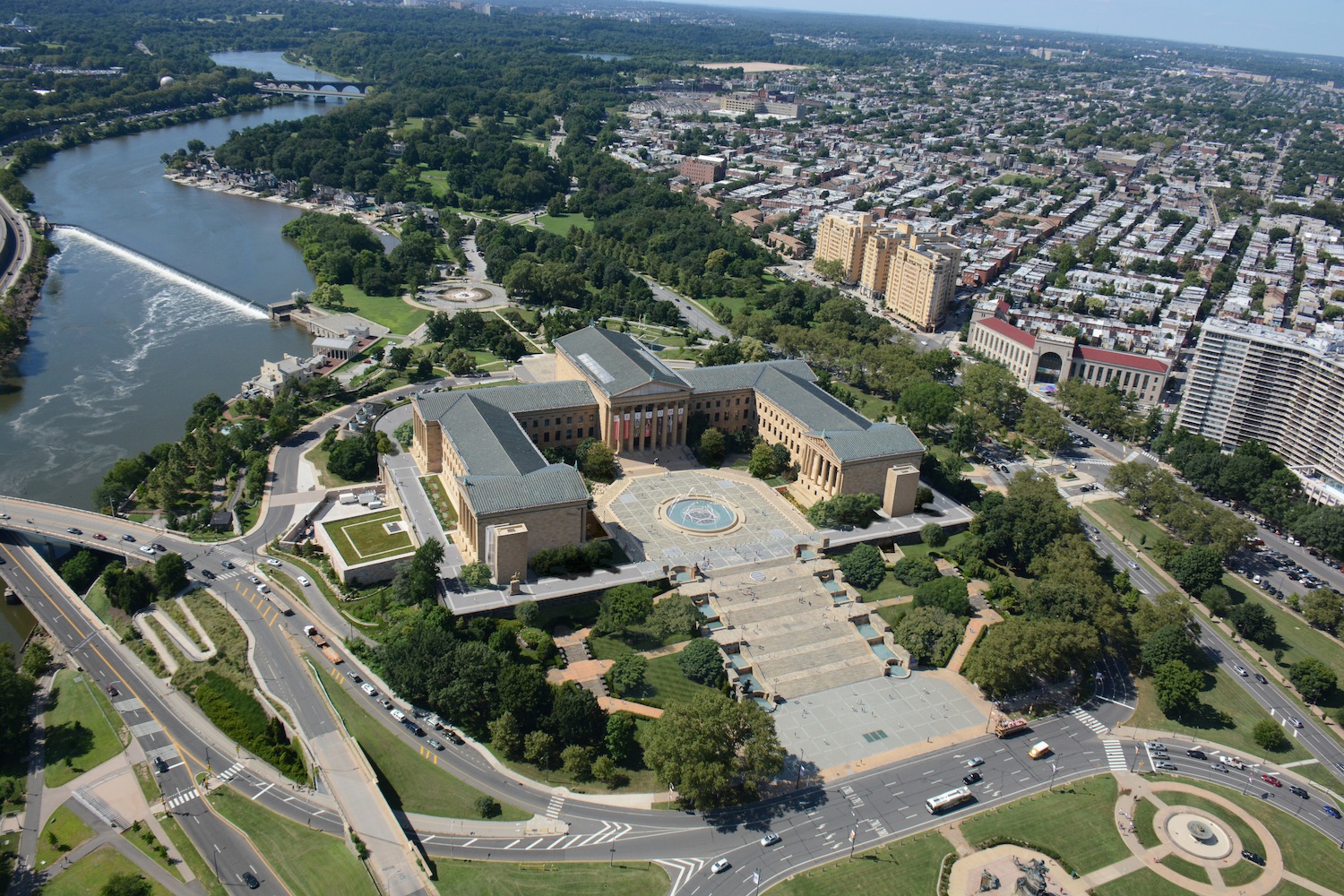
East Terrace with famed "Rocky steps." Rendering: Gehry Partners
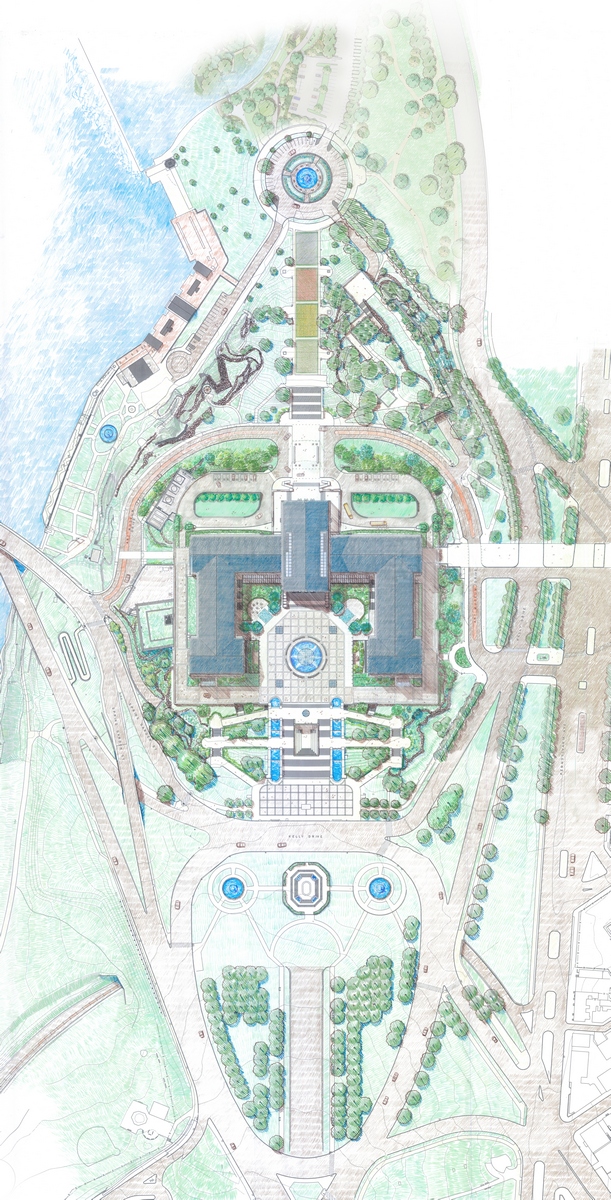
PMA Rendered Plan, OLIN
Related Stories
| Aug 11, 2010
More construction firms likely to perform stimulus-funded work in 2010 as funding expands beyond transportation programs
Stimulus funded infrastructure projects are saving and creating more direct construction jobs than initially estimated, according to a new analysis of federal data released today by the Associated General Contractors of America. The analysis also found that more contractors are likely to perform stimulus funded work this year as work starts on many of the non-transportation projects funded in the initial package.
Museums | Aug 11, 2010
Design guidelines for museums, archives, and art storage facilities
This column diagnoses the three most common moisture challenges with museums, archives, and art storage facilities and provides design guidance on how to avoid them.
| Aug 11, 2010
Broadway-style theater headed to Kentucky
One of Kentucky's largest performing arts venues should open in 2011—that's when construction is expected to wrap up on Eastern Kentucky University's Business & Technology Center for Performing Arts. The 93,000-sf Broadway-caliber theater will seat 2,000 audience members and have a 60×24-foot stage proscenium and a fly loft.
| Aug 11, 2010
Citizenship building in Texas targets LEED Silver
The Department of Homeland Security's new U.S. Citizenship and Immigration Services facility in Irving, Texas, was designed by 4240 Architecture and developed by JDL Castle Corporation. The focal point of the two-story, 56,000-sf building is the double-height, glass-walled Ceremony Room where new citizens take the oath.
| Aug 11, 2010
Carpenters' union helping build its own headquarters
The New England Regional Council of Carpenters headquarters in Dorchester, Mass., is taking shape within a 1940s industrial building. The Building Team of ADD Inc., RDK Engineers, Suffolk Construction, and the carpenters' Joint Apprenticeship Training Committee, is giving the old facility a modern makeover by converting the existing two-story structure into a three-story, 75,000-sf, LEED-certif...
| Aug 11, 2010
Utah research facility reflects Native American architecture
A $130 million research facility is being built at University of Utah's Salt Lake City campus. The James L. Sorenson Molecular Biotechnology Building—a USTAR Innovation Center—is being designed by the Atlanta office of Lord Aeck & Sargent, in association with Salt-Lake City-based Architectural Nexus.
| Aug 11, 2010
San Bernardino health center doubles in size
Temecula, Calif.-based EDGE was awarded the contract for California State University San Bernardino's health center renovation and expansion. The two-phase, $4 million project was designed by RSK Associates, San Francisco, and includes an 11,000-sf, tilt-up concrete expansion—which doubles the size of the facility—and site and infrastructure work.
| Aug 11, 2010
Goettsch Partners wins design competition for Soochow Securities HQ in China
Chicago-based Goettsch Partners has been selected to design the Soochow Securities Headquarters, the new office and stock exchange building for Soochow Securities Co. Ltd. The 21-story, 441,300-sf project includes 344,400 sf of office space, an 86,100-sf stock exchange, classrooms, and underground parking.
| Aug 11, 2010
New hospital expands Idaho healthcare options
Ascension Group Architects, Arlington, Texas, is designing a $150 million replacement hospital for Portneuf Medical Center in Pocatello, Idaho. An existing facility will be renovated as part of the project. The new six-story, 320-000-sf complex will house 187 beds, along with an intensive care unit, a cardiovascular care unit, pediatrics, psychiatry, surgical suites, rehabilitation clinic, and ...








